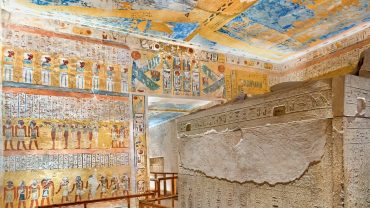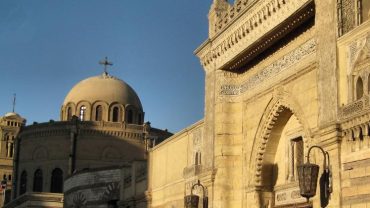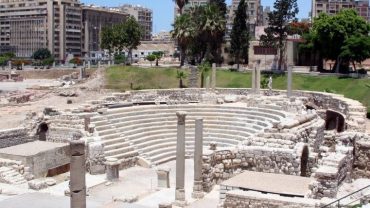Memphis | The First Capital Upper and Lower Ancient Egypt Pharaonic Civilization.
Where is Memphis?
Memphis or the city of Memphis lies 25 km to the south of Cairo, on the west bank of the Nile in Egypt. Mit Rahina is the modern city name of Memphis together with Dahshur, Abusir, and Abu Ghorab south of Cairo and all in Al Badrashin, Giza Governorate.
Moreover, Memphis in ancient times made the boundary between upper Egypt and Lower Egypt. The city was the 1st nome(province) of lower Egypt, in total Lower Egypt has 20 nomes and upper Egypt had 22 nomes. So, in total Upper and lower Egypt were 42 nomes or provinces.
What does it mean Nomes?
Nomes(nomos) is a term of Greek origin that means provinces and it was used to refer to the 42 ancient Egypt provinces. Equally, to what we call today governorate or province. Ancient Egyptians called each nome SEPAT.
Do we know the names of these 42 nomes in ancient Egypt?
Yes, we know them from the reliefs of the temple and shrines. Always the nomes were portrayed at the bottom levels of the walls with what was famous in the nomes like birds, flowers, food, and drinks. Each nome had its own ruler or nomarch, each had its own symbol, sign, or God. In total, there were 22 in Upper Egypt and 20 nomes in Lower Egypt.
Names of the nomes of Lower Egypt | Ta-meḥ means Northern land
- White Walls Nome (Memphis) with main gods Ptah, Sokar, and Apis
- Travelers land with the main gods Horus and Kherty
- Cattle land with the main goddess Hathor
- Southern shield land with main gods Neith and Sobek
- Northern shield land with the main goddess Neith of Sais
- Mountain bull land with the main god Ra
- West harpoon land with the main god HA
- East harpoon land with the main god Atum
- Andjety god land with the main god Osiris of Djedu
- Black bull land with the main god Horus
- Heseb bull land with the main gods Shu, Tefnut, Mihos
- Calf and Cow land with the main goddess Isis of Hebyt
- Prospering Sceptre land with the main god Atum, Iusaas, Mnevis
- Eastmost land with the main god Seth
- Ibis-Tehut land with the main god Thot
- Fish land with the main god Banebdjedet, Hatmehyt
- The throne land with the main god Horus
- Prince of the Southland with the main goddess Bastet
- Prince of the Northland with the main goddess Wadjet
- Plumed Falcon land with the main god Sopdu
Nomes of Upper Egypt | Ta-Shemw Upper Egypt
- Bows land with the main gods Khnum, Satis, Anukis, Isis, Horus the Elder, Sobek
- Throne of Horus land with the main god Horus
- Shrine land with the main god Horus, Nekhbet
- Sceptre land with the main god Amun, Mut, Khons, Montu, Sobek
- The two falcons land with the main god Min, Seth
- The crocodile land with the main god Hathor
- Sistrum land with the main god Bat
- The Great land with the main god Osiris, Onuris
- Min-God land with the main god Min
- Cobra land with the main god Seth, Mihos, Nemty
- Sha-Set animal land with the main god Horus, Seth
- Viper mountain land with the main god Nemty
- Upper Sycamore and Viper land with the main god Anubis
- Lower Sycamore and Viper land with the main god Hathor
- Hares land with the main god Aten
- Oryx Nome with the main god Khnum
- Anubis land with the main god Anubis
- Set land with the main god Nemty
- Two Sceptres land with the main god Seth
- Southern Sycamore land with the main god Heryshef
- Northern Sycamore land with the main god Khnum
- Knife land with the main god Hathor
What was before Memphis, the first Capital? | Upper and Lower Egypt
Historically it is known that Egypt was divided into two kingdoms Upper and Lower Egypt, each one of which used to have its ruler. So, it was one ruler or king for Lower Egypt and one for Upper Egypt.
Each kingdom had its own symbol, so we have the Lotus for lower Egypt and Papyrus for Upper Egypt. Again, two crowns, the Red Crown for Upper Egypt and the White Crown for Lower Egypt. Buto, a town in the northeastern Delta (modern Tell el-Fara’in) in the sixth Lower Egypt was the Capital of Lower Egypt while Nekhn was the capital of Upper Egypt during Prehistoric Egypt.
Upper Egypt
The term Upper Egypt depends on the river Nile as it flows from THE Middle of Africa upstream from Aswan to the Mediterranean Sea downstream. So, from Aswan to Memphis, that was Upper Egypt. Upper Egypt was known by the Egyptian Pharaohs as Ta-Shemau means Land of Reeds.
This part of the country since antiquity is a narrow strip of land along both banks of the river Nile. It was and still is more isolated from the north as the width of the valley is only 1 km on average. The patron goddess of Ancient Upper Egypt is Nekhbet.
Lower Egypt
Lower Egypt is that part of the country that starts from Memphis, the first nome of Lower Egypt to the Mediterranean Sea. Egyptian Pharaohs know Lower Egypt as Ta Mehu means the Land of the North. The patron goddess of Ancient Upper Egypt is Wadjet. On the contrary, in Upper Egypt, Lower Egypt is more industrialized and influenced by trade and commerce with the rest of the world.
Historically it is believed that the two kingdoms were united around 3100BC by the Pharaoh Narmer (Menes) who established the first capital of united Egypt. Finally, it became the first capital of a unified Egypt and a true symbol of the first central government in the history of Egypt and the ancient world.
In the next article, we will discuss the first capital of Egypt Memphis. What was the first capital of ancient Egypt? What did the Ancient Egyptian civilization call Memphis? How long was Memphis the capital of Egypt? What is Memphis Egypt known for? and by the end of the next article, you will know everything about Memphis, the capital, and its necropolis, Saqqara.
What was the first capital of ancient Egypt?
After the unification of Upper and Lower Egypt by King Narmer (Menes), who came from the south near Abydos in Sohag province, Thini village. He thought a new capital for the unified country should be established. Putting in mind, that he was from the south and somehow, he trusted them, he decided to establish the new capital in the north.
King Narmer chose a place to the south of the present Cairo about 25km and built his new Capital. The new capital was called Ineb- Hedj meaning the white wall or the white fortress (which May relate to the white crown of the south). From around 1500 B.C that capital was named Men-Nefer, which was the name of the king Pepi I Meryre Pyramid. The Greeks pronounced the word later Memphis.
Memphis was not the only name for that new capital, relate to its location between upper and lower Egypt, the city was called Mekhat Tawy, the balance of the two lands. Finally, they gave the city the name of the Ptah temple in the area called Hout Ka Ptah meaning The Mansion of Ptah’s Ka. Later on, in the 7th century, the Greeks pronounced the name Aiguptos which later became Egypt, the name of the whole country.
Memphis was not only famous as a capital and religious center but also was the place where Memphite Theology was created. One of the sources of Egyptian History Palermo Stone mentioned that the Egyptian Pharoah kings used to celebrate their religious feasts in Memphis like the Heb-Sed feast.
Overall, the importance of the city came from the point that Memphis was the end of Upper Egypt and the beginning of lower Egypt. In other words, it provided complete control over Lower Egypt which might give more trouble than Upper Egypt.
According to Herodotus, Menes or Narmer founded the city on the west bank of the Nile River because he wanted to avoid the danger of the tribes of the eastern desert. We can abbreviate the situation as follows, one of the Nile branches reached or covered the area of Memphis at that time.
Menes to protect his capital, The king dug another two branches to the west and north. Thus, Memphis became protected from 3 sides by the Nile branches then he built a wall around it from all sides except the south. The wall most probably was similar to the one around the Djoser complex.
Memphis as the capital had the palace of the king and continued as a fortified royal residence and administrative place. Ptah temple was inside the capital then the official and domestic quarters grow around.
Memphis lasts the capital of Egypt till the kings of the 11th dynasty moved the capital to Thebes, later Luxor in Upper Egypt. The kings of the 12th dynasty, the Middle kingdom established a new capital Itjet-Tawy in Lower Egypt where they built their Pyramids. Although, the capital has later been changed many times since The New Kingdom of Ancient Egypt from Luxor to Per-Ramesses and Tanis in the Delta. After all, Memphis kept its importance as the military and administrative capital of the state.




Comment (0)